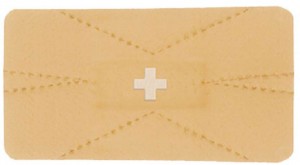Band-Aids; we have all used them, from minor scrapes to cuts and even bug bites. We see them at the doctor’s office, the hospital, and the pharmacy. Generally, Band-Aids are the same: a piece of gauze surrounded by an adhesive strip. Though they do come in all shapes and sizes, we usually see and experience them looking like this:
That’s right! They were invented in 1920, which in turn makes the Band-Aid 93 years-old. They were created by Earle Dickinson and manufactured by Johnson & Johnson. What is interesting to look at is the innovation of the Band-Aid over its long life span. We have Band-Aids that are for large wounds, ones that wrap around, others with built in antiseptic on the gauze pad, and even little circle ones for small cuts. The product itself has undergone changes, but understandably, the process remains the same, attaching a gauze pad to a piece of tape (later a vinyl adhesive) and covering it in crinoline to keep it sterile. This process is done regardless of shape and size, and for the antiseptic ones, there is one extra step in the manufacturing process to add the disinfectant.
Enter Tsai Cheng-Yu and Hsu Hao-Ming. They have created the new Band-Aid, the AmoeBand. It claims to be more comfortable thanks to it being adjustable with perforated edges as well as a pH sensitive gauze pad which will tell the consumer whether or not the wound is infected. This design is a drastic change from the original that is mass produced. How could a company compete with this product, if it’s popular with consumers, if they have to change their whole process design of manufacturing?

Think of how much money would have to be spent either creating new manufacturing facilities or altering current ones. Even further, this process would have to be planned, designed, tested, and eventually perfected. The AmoeBAND adds the necessity to purchase pH sensitive gauze and add a manufacturing step to ensure the perforations. It is easy to understand from labs in class that a process is never perfect and differs. While each AmoeBand manufacturer may believe they have the fastest process, another may have a cheaper process. There are a lot of factors that will go into actual implementation of this product, if it were to become popular amongst consumers.
However, before all that, there will be the need to convince upper management of companies that this is the product of the future, a product that will reap larger reward, and could be easier to manufacture. That will take research, development, and sturdy planning. Band-Aids have not changed much since the 1920’s, so this could revolutionize the industry and push forward innovation.
Do you think a product like this could be produced by companies to net a positive gain? Would the AmoeBand even catch on with consumers?
Sources:
Mary Bellis: http://inventors.about.com/od/bstartinventions/a/bandaid.htm
Article:
Cristina Lindblad: http://www.businessweek.com/articles/2013-03-14/reinventions-band-aid
